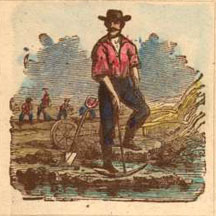 California Grand Festival March included
vignettes of a mustachioed miner and a grizzly bear on its cover in 1890. The
miner at the left in the copy from The Bancroft Library, Univ. of Calif., Berkeley, has
been handcolored by an owner.
California Grand Festival March included
vignettes of a mustachioed miner and a grizzly bear on its cover in 1890. The
miner at the left in the copy from The Bancroft Library, Univ. of Calif., Berkeley, has
been handcolored by an owner.
 California Grand Festival March included
vignettes of a mustachioed miner and a grizzly bear on its cover in 1890. The
miner at the left in the copy from The Bancroft Library, Univ. of Calif., Berkeley, has
been handcolored by an owner.
California Grand Festival March included
vignettes of a mustachioed miner and a grizzly bear on its cover in 1890. The
miner at the left in the copy from The Bancroft Library, Univ. of Calif., Berkeley, has
been handcolored by an owner.
In 1875 a lithograph by Britton and Rey of the Consolidated Virginia Mining Co. Mill graced the cover of the Bonanza Waltz, written by Miss Mary J. Shawhan, aged nine years, and dedicated to Messrs. Flood and O'Brien.
In 1894 the San Francisco Midwinter Fair included a section on mining, memorialized in "Gold Gulch" ("Arroyo de oro") shown on the cover in a number of photographs. By 1898 gold mining was a nostalgic memory in "The Halcyon Days of '49" with its chorus "Beans and bacon, bacon and beans" and illustration of a miner stirring same in an outdoor pot.
Published during the Civil War, "Gold is King"
has six verses in praise of the miner (words by Thomas S. Williams, music
by Gustave A. Scott). The work is dedicated "To the miners of California and
Washoe, Who by Free Labor and Free Votes have demonstrated to the Union that
Cotton is not King." The idyllic woodcut at left matches the idyllic nature
of the text.
Many mining towns sponsored bands formed and directed by the new immigrants and provided with uniforms by sponsors from the mine. The cover of the "Green Mountain March" (1887) includes a portrait of Bandmaster Antonio Arrighini together with the names of the "young Italians" who played in the band and worked in the Green Mountain Mine of Crescent Mills.
The Alaskan mining boom of the end of the century is pictured in a dogsled group heading into snow-covered mountains in "The Chilkoot March." "Klondike Gold" (1898) carries a picture of a dashing miner in a fur-trimmed outfit.